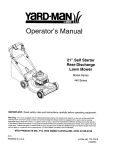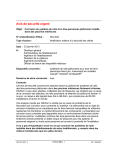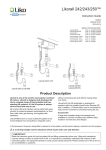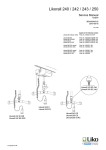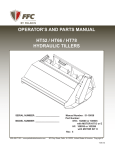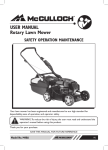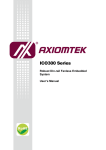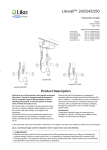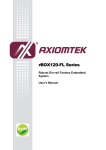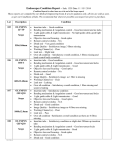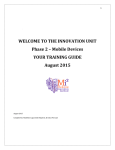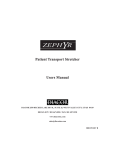Download Instructions for inspection points
Transcript
6.1 Likorall™ Likorall 200, 240, 242, 243, 250 Periodic inspection 2014-06-26 Customer Reference: Lift type: .............................................................. Contract No: .................................................................. Prod No: Version: .............................................................. Name: .................................................................. Serial No: .............................................................. Address: .................................................................. (Zip Code) .................................................................. Prod. Year: .............................................................. The patient lift must be thoroughly inspected at least once per year. Inspection and service must be carried out by Hill-Rom/Liko authorized personnel. If the system is installed in a corrosive environment such as indoor pool or bathroom, please see section 15 before starting inspection. Make a color print of this instruction. INSPECTION POINTS 1 2 3 4 5 6 7 8a 8b 9 10 11 Approved Generalinspection Carriages Emergency Stop Hand control Electrical emergency lowering device SSP Limit Switch Lift Strap Mechanical emergency lowering (242) Fixed strap-stop (242) TDM & R2R Hook (200 & 242 R2R) Slingbar Charger function Not approved To be actioned: ............................................................................. ............................................................................. ............................................................................. ............................................................................. ............................................................................. ............................................................................. ............................................................................. ............................................................................. ............................................................................. ............................................................................. ............................................................................. ............................................................................. LOAD TESTING 12 Mechanical lowering load test (242) 13 Maximumloadrailsystem ............................................................................. ............................................................................. DOCUMENTATION 14 Instructions/Instructionguide ............................................................................. ENVIRONMENTAL IMPACT 15 Corrosiveenvironments ............................................................................. Approval to use the patient lift Approved Not approved To be actioned If the patient lift has one or more inspection point with result “Not approved” the system must not be used. If the system has one or more inspection point with result “To be actioned” these actions should be performed immediatley. After performed actions sign below. If anything is unclear or if you have questions, please contact Hill-Rom/Liko or your local Hill-Rom/Liko representative. Contact information is to be found at www.liko.com. Inspection performed by: ____________________________________ Date: ____________________ Final approval by: _____________________________________ Approval date: ____________ Next inspection: _____________________________________ Inspection performed in accordance with ISO 10535:2006 Annex B- Periodic inspection 106 www.liko.com www.liko.com Periodic Inspection Likorall © Copyright Liko AB 6.1 Instructions for Likorall™ the inspection points Inspection points Likorall 200 Likorall 242 2 1 3 2 5 6 7 1 3 8b 8a 6 5 10 7 4 9 9 10 4 R2R Likorall 243 & 250 2 1 3 5 6 7 10 4 Periodic Inspection Likorall Periodic Inspection Likorall 107 www.liko.com www.liko.com 6.1 Likorall™ Instructions for the inspection points 1 - General inspection Verify presence of decal with model type and serial number. Check the front plastic cover for cracks. Check rear plastic cover for cracks and that the end-cover screws are in place. Check aluminium body for dents or scratches. 2 Carriages - Verify that carriages are secured to motor with bolts and nyloc nuts. - Roll the carriage within the rail. Verify that each wheel turns freely and the plastic wheel bearing covers not are cracked or missing. R2R Turnable Hanger: - Verify that the centre pin is held secure with a split pin. Carriage with brake: - If applicable, check that the carriage brake assembly tightens and holds. - Check the brake function of the carriage. 3 Emergency Stop - Press in the emergency stop button. Verify that it holds and locks in the closed position. If the emergency stop cord is attached, check that it is secured properly. - With the Emergency Stop button pressed in, check that the motor does not operate when the hand control buttons are pressed. - Turn the red emergency button in the direction of the arrows. Verify that the button releases from the locked position into the raised, open position. 4 - Hand control Check cord for exposed wear or tear in the insulation sleeve. Inspect casing for damage, verify dust & water seal is intact. With the emergency-stop out, press each button and check for corresponding lift operation. 5 Electrical emergency lowering device - Test the electrical emergency lowering device by pulling down the handle (Likorall 200) or pressing the up and down arrows on the electronic card cover. Check for corresponding lift operation. 6 - SSP Limit Switch Check that the (2) mounting screws secure the micro switch e-card to the motor casing. Check function of twist protection. With the emergency stop out, move the lifts trap all the way up against the SSP Limit switch. Check that the motor does not operate when touching the SSP Limit switch. 7 Lift Strap - Using the hand control, lower the strap to its maximum extension. Inspect the belt for frayed edges, heavy wrinkles or wear-through areas. - Verify that the Q-link is secure on strap. Slide plastic cover off the Q-link and visually inspect that the lifts trap safety pin is seated securely in the middle recess of the Q-link. 8a Mechanical emergency lowering (Likorall 242) - Make sure the hole at the emergency lowering not exceeds 12 mm / 0,47 inch. - EMERGENCY LOWERING Attach the sling bar to the lift strap. Make sure the sling bar is correctly mounted. Verify the position of the red plastic adjustable stop at the top of the Spring magazine. Ensurethatthesnap-fitisinterlockedandsecure. Apply slight manual downward pressure on the sling bar. Simultaneously pump the red handle on the mechanical emergency-lowering. Verify that the spring action handle lowers and recoils upward and that the strap is let out of the Spring magazine. Manually elevate the sling bar so there is no weight on the mechanical lowering assembly. Simultaneously pump the red handle until the strap rewinds up to the red plastic adjustable stop. Ensure that the red plastic handle cover is in place. 8b Fixed strap-stop (Likorall 242) - Verify that screws (2) are tight in two-piece assembly - If requested and/or necessary, reset the strap-stop height according to service manual instructions. Periodic Inspection Likorall Periodic Inspection Likorall 108 www.liko.com www.liko.com 6.1 Likorall™ Instructions for the inspection points 9 - TDM & R2R Hook (Likorall 242 R2R and Likorall 200) Manually press and lower the plastic covers and spring assembly away from the aluminium hook. Release the springassemblyandverifythatthespringsnapsbackagainstthehook,providingasecuresnap-fitlock. Verify that the screw joints are tight. 10 Sling bar - Visually inspect the sling bar to detect any scratches, sharp edges or deformities. - Check that the unit rotates freely on its bearings. - Make sure both safety latch clips are mounted and fall back against the body of the sling bar. - Verify that the sling bar fasteners are tight. - On old model of sling bar, made of steel; Verify that the o-ring is present and positioned in the center bolt groove. 11 Charger function - With the emergency stop out, insert the hand control into the wall-mounted charger outlet (110 - 240V). Visually inspect that diode lights on the charger unit and hand control light up according to the User Manual or the Quick reference guide. Load testing 12 Mechanical lowering load test (50 kg / 110 lbs) (Likorall 242) With the emergency stop out, and the strap with the sling bar lowered, secure the weights. Using the hand control, raise the weights approximately 10-15 cm (4-6 inch). Firmly apply increasing downward pressure on the red emergency-lowering handle until the strap begins to slowlylowertheweighttothefloor.Removetheweightsandrewindthestraptoitsoriginalposition,as described in inspection point 8a. 13 Maximum-load test Likorall 200: 200 kg / 440 lbs Likorall 240: 180 kg / 400 lbs Likorall 242: 200 kg / 440 lbs Likorall 243: 230 kg / 507 lbs Likorall 250: 250 kg / 550 lbs Stop - With the emergency stop out, and the strap with the sling bar lowered, secure the weights. Using the hand control, raise the maximum load 50 cm Make sure the lift strap does not drift more than 15 cm (6 inch)/ 30 sec. Lower the maximum load to the start position. Listen for peculiar noises and vibrations. Max.load Note: Never go below start position with the maximum load! Make sure the batteries are fully charged before maximum load test! If the low-battery alarm sounds during the lift, the battery must be recharged prior to load testing. If the low-battery alarm sounds during the lift with fully recharged batteries, the batteries must be replaced. 50cm Start Documentation 14 Instructions / Instruction guide. - Make sure Instruction guide or Quick reference guide, to the lift unit, are available. Periodic Inspection Likorall Periodic Inspection Likorall 109 www.liko.com www.liko.com 6.1 Likorall™ Instructions for the inspection points 15 Environmental Impact – corrosive environments Due to the environment an overhead system is installed in, components may be subject to corrosion. High temperature, high relative humidity, poor ventilation, presence of chlorine and different combinations of these factors, will affect the corrosion rate. Depending on material type a corrosion attack can occur suddenly or in other cases form gradually. The corrosion rate and type of corrosion attack might be different in one area of the installation compared to another. Fixing points classified as safety critical, installed in a corrosive environment such as indoor pool or bathroom, must be inspected. When a component has reached a certain stage of corrosion it might need to be replaced. Note! Print out in color. Check for visible severe corrosion and material loss and identify if components need to be replaced. Galvanized steel These pictures describes the evaluation method for all galvanized steel components. 1. New bolt 2. Acceptable 3. Replace 4. NOT acceptable 1. A galvanized steel component. 2. White rust on a component appears when the surface treatment corrodes. 3. Red rust appears when the actual steel has started to corrode. Corroding steel will result in material loss and should therefore be replaced. 4.Acomponentcoveredinredrustisunfitforuse. Powder coated steel These pictures describes the evaluation method for all powder coated steel components. 1. New 2. Acceptable 3. Replace 4. NOT acceptable 1. A powder coated steel component. 2. Local discoloration may occur in close proximity to corroding non-painted components. Stains on the painted surface is acceptable. 3. Cracks in the paint and red corrosion under the paint is a sign of corroding steel. Corroding steel will result in material loss and should therefore be replaced. 4.Acomponentwithpeelingcoating,bubblesinthepaintandredcorrosionunderthepaintisunfittouse. Periodic Inspection Likorall Periodic Inspection Likorall 110 www.liko.com www.liko.com Likorall™ Instructions for the inspection points Safety critical fixing points: • Carrier bolts and pins • Load bearing components below lift motor. Periodic Inspection Likorall 6.1 Example of load bearing parts: 111 www.liko.com Likorall™ 3EN200405 Rev. 9 112 www.liko.com 6.2 Likorall™ Rail system Periodic Inspection 3EN111001 Rev 10 System information Customer references Type of Rail system: .................................................. Agreement No: ............................................................. S/N: Name: ............................................................. Approved Max Load: .................................................. Address: ............................................................. Year of Installation: Post code: ............................................................. .................................................. .................................................. The Rail System must be thoroughly inspected at least once per year. Inspection and service must be carried out by Hill-Rom/Liko authorized personnel. See Installation condition checklist on next page to determine how to perform inspection points 1 and 3. Make a color print of this instruction. INSPECTION POINTS Approved INSTALLATION 1 Generalinspection 2 Labels/Signs 3 Ceiling/Pendant/CeilingFixture 4 Wall/WallBracket Not approved To be actioned: ............................................................................. ............................................................................. ............................................................................. ............................................................................. LOAD-BEARING PARTS / RAIL SYSTEM 5 UprightSupport 6 Primaryrail 7 SecondaryRail 8 TraverseCarriage 9 Endstop 10 RailJoint ............................................................................. ............................................................................. ............................................................................. ............................................................................. ............................................................................. ............................................................................. POWER UNIT 11 Liftmotor ............................................................................. LOAD TESTING 12 Maximumloadrailsystem 13 Extendedmaximumloadtest ............................................................................. ............................................................................. DOCUMENTATION 14 Instructions / Instruction guide ............................................................................. ENVIRONMENTAL IMPACT 15 Corrosiveenvironments ............................................................................. Approval to use the overhead system Approved Not approved To be actioned Not approved: If the system has one or more inspection points with result “Not approved” the system must not be used. To be actioned: Actions according to the “Instructions for the inspection points” should be performed immediatley. After performed actions sign below. If anything is unclear or if you have questions, please contact Hill-Rom/Liko or your local Hill-Rom/Liko representative. Contact information is to be found at www.liko.com. Inspection performed by: ____________________________________ Date: ____________________ Final approval by: _____________________________________ Approval date: ____________ Next inspection: _____________________________________ Inspection performed in accordance with ISO 10535:2006 Annex B- Periodic inspection 113 www.liko.com www.liko.com Periodic Inspection Rail System © Copyright Liko AB, 2014 June 6.2 Likorall™ Installation condition checklist Instructions for inspection points This checklist helps to determine ways to perform inspection points 1 and 3, depending on what environment the system is installed in. All other inspection points has to be performed according to the instructions. Environment: Non corrosive environment Corrosive environment e.g. bathroom or other high humidity environment. Accessible fixing points: Partly accessible fixing points: Non accessible fixing points: All attachments are visible E.g. false ceiling with inspection hatches E.g. false ceiling • • • • Inspectaminimumof 20%(atleasttwo)of thefixingpoints. • Inspectallfixingpoints. • Performcorrosion inspectionaccordingto section15. • • Chlorinated corrosive environment • e.g. indoor pool Periodic Inspection Rail System, 3EN111001 Rev. 10 Periodic Inspection Rail System • Inspectallfixingpoints. • Performcorrosion • inspectionaccordingto section15. 114 Inspectaminimumof • 20%(atleasttwo)of thefixingpoints. Iflessthan20%can beinspected,extended maximumloadtest mustbeperformed onnonvisiblefixing points,accordingto section13 Extendedmaximum loadtestaccordingto section13. Inspectaminimumof • 20%(atleasttwo)of thefixingpoints. Iflessthan20%can beinspected,extended maximumloadtest mustbeperformed onnonvisiblefixing points,accordingto section13 Performcorrosion inspectionaccordingto section15. Extendedmaximum loadtestaccordingto section13. Inspectallfixingpoints. • Performcorrosion inspectionaccordingto • section15. NOTE! Make inspection with inspection hatches or similar. Inspectallfixing points. Performcorrosion inspectionaccordingto section15. NOTE! Make inspection with inspection hatches or similar. www.liko.com www.liko.com Likorall™ Instructions for inspection points 6.2 3 4 8 5 2 6 11 10 9 7 1 General inspection • • • • • Verify that there is a valid Installation Certificate for the overhead lift system. Inspect that the distance between the installation points and the overhang match the instructions for the rail and the max load for installed lift unit. Se Tables in Overhead System Installation Hand Book. Inspect that the overhead lift system has no visible damage or deformation. Inspect a minimum of 20% of the fixing points to make sure that bolts and nuts are not loose, or see “Installation condition checklist” on previous page if fixing points are unaccessible. Use the appropriate inspection method for the bolts. (This is given by the supplier of the bolt.) 2 Decal / Labels • • Inspect the S/N on the label, if available Make sure the maximum load at the decal on the rail, is equal to, or larger than the maximum load for the lift unit installed in the system. Serie No / Serial No xxxxxx Märklast / Max load kg TESTED www.liko.com 3 Ceiling / Pendant / Ceiling Fixture • • Inspect a minimum of 20% (at least two) of the fixing points to make sure that bolts and nuts are not loose, or see “Installation condition checklist” on previous page if fixing points are unaccessible. (See 1 General inspection) Periodic Inspection Rail System, 3EN111001 Rev.10 Periodic Inspection Rail System 115 www.liko.com www.liko.com 6.2 Likorall™ Instructions for inspection points 4 Wall / Wall Bracket • • Inspect that there is no play between the wall and the bracket. Inspectthefixingbetweentherailandthewallbracket. 5 Upright Support • • • Make sure that there is no play between the fixingpoints in the wall and the upright support. Inspectthefixingbetweenthewallandtheupright support. Inspectthefloorfordamage/deflectionaroundthe bottom of the upright support. 6 Primary rail, ( straight rail, traverse ) • • • Makesurethereareatleasttwofixingsperrail. Inspect that joint gap is max 2 mm / 0,08 inch. (A) Makesurethattherailjointissupportedbyafixingora proper joint section. (A) 7 Secondary Rail • Inspect that the drawing affect in the system is acceptable, by placing a force (F) on one side. The secondary rail (B) should then run freely. (B) F 8 Traverse Carriage • Inspect that the carriers are functioning correctly without exercise. Listen for abnormal sounds from movable parts. Periodic Inspection Rail System Periodic Inspection Rail System, 3EN111001 Rev.10 116 www.liko.com www.liko.com Likorall™ Instructions for inspection points Instructions for inspection points 6.2 9 End stop Inspect 9• End stop that safetythrough bolts with locking nuts are mounted. • Inspect that safetythrough bolts with locking nuts are • mounted. Inspect that the end stop is correctly mounted. • Inspect that the end stop is correctly mounted. 10 Rail Joint (in rail, pendant and ceiling bracket) • Rail Inspect to make that bracket) bolts and nuts 10 Jointthe (inRail rail,Joint pendant andsure ceiling are tightened and there is no play between parts. • Inspect the Rail Joint to make sure that boltsthe and nuts • are Make sure theand Railthere Jointisisno assembled with the parts. joints in tightened play between the middle. • Make sure the Rail Joint is assembled with the joints in the middle. 11 Lift motor • Lift See Periodic inspection for the particular lift /product in the rail system. 11 motor (Available at www.partner.liko.net) • See Periodic inspection for the particular lift /product in the rail system. (Available at www.partner.liko.net) 12 Maximum load rail system • Maximum Carry out load load test lift motor carriages and rail 12 rail with system system, using maximum for carriages the rail system, across • Carry out load test with liftload motor and rail the whole lifting area, by load manoeuvre the system, load along system, using maximum for the rail across each primary rail, andby then in a Z pattern. the whole lifting area, manoeuvre the load along • each Listenprimary for unusual noises rail, and thenand in avibrations. Z pattern.Check for any abnormalitiessuchasdeflection,abnormalmovement • Listen for unusual noises and vibrations. Check for any or resistance. abnormalitiessuchasdeflection,abnormalmovement or resistance. Periodic Inspection Rail System Periodic Inspection Rail System, 3EN111001 Rev. 10 117 www.liko.com www.liko.com 6.2 Likorall™ Instructions for inspection points 13A Extended maximum load test STRAIGHT RAIL SYSTEM • • Apply the maximum load for the overhead rail system. Travel the applied load along the rail from one end stoptotheotherendstop,withapauseundereachfixingpoint.Travelasthedashedlineshows. Listenforunusualnoisesandvibrations.Checkforanyabnormalitiessuchasdeflection,movementor resistance. Pendant End Stop Carriage Pendant Primary rail Max.load Max.load 1 2 Pause Attachment 1 etc. End stop End stop Carriage Rail Max.load Periodic Inspection Rail System Periodic Inspection Rail System, 3EN111001 Rev. 10 118 www.liko.com www.liko.com 6.2 Likorall™ Instructions for inspection points 13B Extended maximum load test TRAVERSE SYSTEM • • • • • Apply the maximum load for the overhead rail system. Place the carriage with the applied load at the end stop of the secondary rail (1). Move the secondary rail, withapauseundereachfixingpoint,fromoneendstoptotheotherendstopofthefirstprimaryrail. Continue by moving the applied load diagonally through the centre of the system over to the other side, as the dashed line shows. Nowcontinuebymovingthesecondaryrailwiththeappliedload,from(2),withapauseundereachfixing point, from one end stop to the other end stop of the second primary rail. Listenforunusualnoisesandvibrations.Checkforanyabnormalitiessuchasdeflection,movementor resistance. Primary rail End Stop Carriage Primary rail Secondary rail Max.load Max.load 1 2 Secondary rail Max.load Max.load Pause Attachment 1 etc. End stop End stop Secondary rail Max.load End stop End stop 1 Periodic Inspection Rail System Periodic Inspection Rail System, 3EN111001 Rev. 10 Max.load 2 119 www.liko.com www.liko.com 6.2 Likorall™ Instructions for inspection points 14 Instructions / Instruction guide • Make sure Instruction guide or Quick reference guide, to the lift unit, are available. 15 Environmental Impact – corrosive environments Due to the environment an overhead system is installed in, components may be subject to corrosion. High temperature, high relative humidity, poor ventilation, presence of chlorine and different combinations of these factors, will affect the corrosion rate. Depending on material type a corrosion attack can occur suddenly or in other cases form gradually. The corrosion rate and type of corrosion attack might be different in one area of the installation compared to another. Fixing points classified as safety critical, installed in a corrosive environment such as indoor pool or bathroom, must be inspected. When a component has reached a certain stage of corrosion it might need to be replaced. Note! Print out in color. Check for visible severe corrosion and material loss and identify if components need to be replaced. Galvanized steel These pictures describes the evaluation method for all galvanized steel components. 1. New bolt 2. Acceptable 3. Replace 4. NOT acceptable 1. A galvanized steel component. 2. White rust on a component appears when the surface treatment corrodes. 3. Red rust appears when the actual steel has started to corrode. Corroding steel will result in material loss and should therefore be replaced. 4.Acomponentcoveredinredrustisunfitforuse. Powder coated steel These pictures describes the evaluation method for all powder coated steel components. 1. New 2. Acceptable 3. Replace 4. NOT acceptable 1. A powder coated steel component. 2. Local discoloration may occur in close proximity to corroding non-painted components. Stains on the painted surface is acceptable. 3. Cracks in the paint and red corrosion under the paint is a sign of corroding steel. Corroding steel will result in material loss and should therefore be replaced. 4.Acomponentwithpeelingcoating,bubblesinthepaintandredcorrosionunderthepaintisunfittouse. Periodic Inspection Rail System Periodic Inspection Rail System, 3EN111001 Rev. 10 120 www.liko.com www.liko.com 6.2 Likorall™ Instructions for inspection points Safetycriticalfixingpoints: • Ceiling and wall attachments • Load bearing bolts and nuts in Example of load bearing bolts and nuts: - Pendants - Ceiling and wall brackets - Traverse carriers - Switches and turntables • End stop Periodic Inspection Rail System Periodic Inspection Rail System, 3EN111001 Rev. 10 121 www.liko.com www.liko.com Likorall™ 3EN200405 Rev. 9 122 www.liko.com 7.1 Likorall™ Likorall 200/240/242/243/250 Preventative Maintenance 2013-11-05 Customer Reference: Contract No: Lift type: Product No: Name: Version: Serial No: Address: Prod. Year: (Zip Code) To ensure maximum life cycle should Preventative Maintenance be carried out according to the table below. Inspection and service must be carried by HillRom/Liko authorized personnel. Instructions for the check points, from the next page. Check points: Carriage Month 12 24 36 48 60 72 84 96 108 120 1 Carriage cleaning ........................................................................... 2 Bearing inspection.......................................................................... Bearing replacement ...................................................................... Motor 3 Lift strap replacement..................................................................... 4 Battery inspection........................................................................... Battery replacement ....................................................................... 5 Sling bar ........................................................................................ Interval/Month: Date: Serviced by: 3EN200405 Rev. 9 123 www.liko.com 7.1 Likorall™ Check points 1 2 4A&B 3 5 Instructions regarding the check points for Likorall 200/240/242/243/250 1. Carriage cleaning Tools required 13 mm A. Remove the carriage from the rail and clean the wheels and the inside surface of rails with a moist cloth. Adjustable brake B. Place carriage in rail, mount motor. Tighten carriage screws. Adjust the brake on the carriage (friction brake). 3EN200405 Rev. 9 124 www.liko.com 7.1 Likorall™ Likorall 200/240/242/243/250 2. Bearing inspection and replacement Tools required Spare part No: 31290060 Plastic wheel with bearing. Not for IRC-carriage 3126114 and IRC Traverse Adapter 3102540 Bearing replacement recommended every 5th year 3. Lift strap replacement Spare part No. according to spare part list. Lift strap replacement recommended every 5th year 4 Battery inspection and replacement Tools required 3 mm 200 Battery tester Prod. No. 2101100 - Remove the cover by unfasten the 4 screws and than pull out the batteries. - Check the battery with Battery tester Prod. No. 2101100, signal should be audible for more than 5 sec. If not, replace battery with Spare part No. 31290007. - Replace battery according to assembly instruction for Spare part 31290007. Battery replacement recommended every 3rd year 3EN200405 Rev. 9 125 www.liko.com 7.1 Likorall™ Likorall 200/240/242/243/250 5. Sling bar cleaning Tools required Only on SlingBar Standard: 17 mm 6 mm A. Unfasten sling bar from Likorall. B. Clean sling bar and center bolt on old type of slingbar. Cleaning of sling bar and center bolt recommended every year 3EN200405 Rev. 9 126 www.liko.com 8.0 Likorall™ Likorall 200 / 240 / 242 / 243 / 250 Product changes Likorall 243 ES, NA Likorall 250 ES, NA Likorall 200 Likorall 242 S Likorall 242 ES Likorall 242 S R2R Likorall 242 ES R2R Likorall 243 ES Likorall 250 ES Likorall 250 S IRC Likorall 200 Prod. No. 3121001 Likorall 242 ES Likorall 242 ES R2R Likorall 242 S Likorall 242 S R2R Prod. No. 3122005-3122006 / NA Prod. No. 3122007-3122008 / NA Prod. No. 3122009-3122010 / NA Prod. No. 3122011-3122012 / NA Likorall 243 ES, natural Likorall 243 ES, white Prod. No. 3123001 / NA Prod. No. 3123002 / NA Likorall 250 ES, natural Likorall 250 ES, white Likorall 250 S, IRC Prod. No. 3122501 / NA Prod. No. 3122502 / NA Prod. No. 3124050 Likorall 240 natural / white Likorall 242 natural / white Prod. No. 3120001-3121617 - Discontinued 2004 Prod. No. 3122001-3122004 - Discontinued 2004 2013 Changes Type Prod. No. Rev. From S/N Proj. Spareparts to old versions of Likorall has been discontinued. Likorall 240 31290052 31290053 31290005 - - 1910 - The liftstraps has been modified. New type of seam and new 145 mm long treaded bolt. All Lift Strap Spare Parts has got new spare part numbers. (see Spare Parts List) Likorall 200 3121001 02 8 411 000 1797 Likorall 242 S 3122009 3122010 3122011 3122012 3122009NA 3122010NA 3122011NA 3122012NA 02 02 02 02 02 02 02 02 8 024 000 8 024 000 8 024 000 8 024 000 286 200 286 200 286 200 286 200 Likorall 242 ES 3122005 3122006 3122007 3122008 3122005NA 3122006NA 3122007NA 3122008NA 02 02 02 02 02 02 02 02 8 103 700 8 103 700 8 103 700 8 103 700 429 200 429 200 429 200 429 200 Likorall 243 ES 3123001 3123002 3123001NA 3123002NA 02 02 02 02 8 205 400 8 205 400 368 200 368 200 Likorall 250 ES 3122501 3122502 3122501NA 3122502NA 02 02 02 02 8 306 300 8 306 300 6 604 200 6 604 200 Likorall 250 S IRC 3124050 02 5 500 3EN200405 Rev. 9 127 www.liko.com 8.0 Likorall™ 200 / 240 / 242 / 243 / 250 Product changes 2012 Changes Type Prod. No. Rev. From S/N: Proj. - New longer and grey lift straps. - The motor has been modified. - New version of PCBA - Revision numbers (Rev.) are implemented. It is visible on the product label at the lift and on the packaging label. - Clearifying instructions regarding maximum load testing has been inserted in our documentation. (never go below start position with max load) Likorall 200 3121001 01 8 406 676 Likorall 242 S 3122009 3122010 3122011 3122012 3122009NA 3122010NA 3122011NA 3122012NA 01 01 01 01 01 01 01 01 8 000 001 8 000 001 8 000 001 8 000 001 260 001 260 001 260 001 260 001 1748 1817 Likorall 242 ES 3122005 3122006 3122007 3122008 3122005NA 3122006NA 3122007NA 3122008NA 01 01 01 01 01 01 01 01 8 100 001 8 100 001 8 100 001 8 100 001 420 001 420 001 420 001 420 001 Likorall 243 ES 3123001 3123002 3123001NA 3123002NA 01 01 01 01 8 200 001 8 200 001 362 301 362 301 Likorall 250 ES 3122501 3122502 3122501NA 3122502NA 01 01 01 01 8 300 001 8 300 001 6 600 001 6 600 001 Likorall 250 S IRC 3124050 01 2001 Changes Type Prod. No. S/N: Due to production problems some Likorall was produced according to proj 754, with shorter black lift strap, old version of motor, and PCBA. Likorall 200 3121001 7 900 001 - 8 405 800 8 405 969 - 8 406 299 Likorall 242 S 3122011 7 920 001 - 8 016 112 8 016 169 - 8 016 399 2011 Temporary solution until project 1748 was released. Likorall • 3EN200405 Rev. 9 128 Proj. www.liko.com 8.0 Likorall™ 200 / 240 / 242 / 243 / 250 Product changes 2011 Changes Type From S/N Project New layout on decal and product labels. Likorall 200 1690/1694 New layout on decal and product labels. Likorall 242 S 1690/1694 Likorall 242 ES Likorall 243 ES Likorall 250 ES Likorall 250 S IRC Spare part 31290078 Emergency guard activator, reintroduces. Changes Likorall 242 S (NA) Likorall 242 ES (NA) Likorall 243 ES (NA) Likorall 250 ES (NA) 285 300 427 700 366 306 6 603 100 Type From S/N Project - The Hand Control Cable is 15 cm longer and more flexible. Likorall 200 - The lifting range has been modified to 205 cm. - New longer lift strap. - The motor has been modified. 8 405 801 1211/1051 - The lifting range has been modified to 205 cm. - New longer and grey lift straps. - The motor has been modified. - New fuse (12A) and fuse holder Likorall 242 S 8 016 001 1211/1051 Likorall 242 ES Likorall 243 ES Likorall 250 ES Likorall 250 S IRC 8 102 001 8 203 501 8 303 501 3000 Proj 1211/1051 was never inplemented on Likorall NA. Likorall 242 S (NA) Likorall 242 ES (NA) Likorall 243 ES (NA) Likorall 250 ES (NA) - Changes Type From S/N Project New type of ceiling lift, prepared for continuous charging through the rail system by In-Rail charging system (IRC) Likorall 250 S IRC 2001-2500 (pre serial) 1099 New cover with integrated emergency stop collar and emergency stop cord. Lift strap equipped with Q-link is now standard on Likorall 243 ES and Likorall 250 ES. Likorall 242 S Likorall 242 ES Likorall 243 ES Likorall 250 ES 8 007 961 8 100 714 8 201 237 8 301 629 754 New cover with integrated emergency stop collar and emergency stop cord. Likorall 200 Likorall 242 S (NA) Likorall 242 ES (NA) Likorall 243 ES (NA) Likorall 250 ES (NA) 8 401 443 284 580 426 991 365 346 6 601 769 2010 Likorall • 3EN200405 Rev. 9 129 www.liko.com 8.0 Likorall™ 200 / 240 / 242 / 243 / 250 Product changes 2009 Changes Type From S/N Project New version of electronic card; version F Likorall 200 8 401 051 1030 Changes Type From S/N Project New version of Electronic card. Likorall 242 S Likorall 242 ES Likorall 243 ES Likorall 250 ES 8 000 001 8 100 001 8 200 001 8 300 001 560 New version of Electronic card. Likorall 242 S (NA) Likorall 242 ES (NA) Likorall 243 ES (NA) Likorall 250 ES (NA) 278 548 425 687 363 741 6 600 301 Changes Type From S/N Project Current limit changed from 10.5A to 11.5A. Likorall 242 ES 424689 383 Safety Squeeze Protection upgraded with Twist Protection. Likorall 242 S Likorall 243 ES Likorall 242 ES 267210 362586 424379 156 Hang-Up for Hand control 266387 424229 362487 183 2007 2005 Likorall 242 S Likorall 242 ES Likorall 243 ES Likorall • 3EN200405 Rev. 9 130 www.liko.com Likorall™ 3EN200405 Rev. 9 131 2.0 www.liko.com © Copyright Liko AB, 2014 June w w w . l i k o . com Manufacturer: Liko AB SE-975 92 Luleå Sweden



























